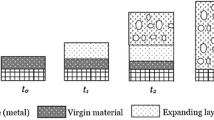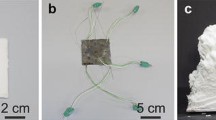Abstract
Intumescent coatings are now the dominant passive fire protection materials used for steel construction. Intumescent coatings will react at high temperatures and the thermal properties of intumescent coatings can not be measured directly by the current standard test methods which are originally designed for the traditional inert fireproofing materials. This paper proposed a simple procedure to assess the fire resistance of intumescent coatings by using the concept of equivalent constant thermal resistance. The procedure is based on the approximate formula for predicting the limiting temperatures of protected steel members subjected to the standard fire. Test data from investigations on both small-scale samples and full-scale steel members are used to calculate the equivalent constant thermal resistance. Using the equivalent constant thermal resistance of intumescent coatings, the calculated steel temperatures agree well with the test data in the range of the limiting temperatures from 400°C to 600°C. The procedure needs no complex computation and is recommended for practical usage. The equivalent constant thermal resistance could be used to quantify the insulation capacity of intumescent coatings.















Similar content being viewed by others
References
Fire resistance OF steel-framed buildings, 2006 edn. Corus Construction and Industrial (2006)
Bourbigot S, Duquesne S, Leroy JM (1999) Modeling of heat transfer of a polypropylene-based intumescent system during combustion. J Fire Sci 17:42–56
Yuan JF (2009) Intumescent coating performance on steel structures under realistic fire conditions. PhD thesis, The University of Manchester
Standard test methos for fire tests of building construction and materials. ASTM E119-00a. ASTM International, West Conshohocken, PA (2000)
GB/T 9978-1999 (1999) Fire-resistance tests—elements of building construction. Chinese National Code
GB 14907-2002 (2002) Fire resistive coating for steel structure. Chinese National Code
Yuan JF, Wang YC (2008) Prediction of intumescent coating performance under cone calorimeter—a mathematical approach to performance based design. In: Proceedings of the fifth international conference on structures in fire (SiF’08), Singapore, pp 713–724
Koo JH (1998) Thermal characterization of a ceramic intumescent material. Fire Technol 34: 59–71
Di Blasi C (2004) Modeling the effects of high radiative heat fluxes on intumescent material decomposition. J Anal Appl Pyrol 71:721--737
Bartholmai M, Schriever R, Schartel B (2003) Influence of external heat flux and coating thickness on the thermal insulation properties of two different intumescent coatings using cone calorimeter and numerical analysis. Fire Mater 27:151–162
Standard test method for steady-state thermal transmission properties by means of the heat flow meter apparatus. ASTM C518-04. ASTM International, West Conshohocken, PA (2003)
GB/T 10294-2008 (2008) Thermal insulation—determination of steady-state thermal resistance and related properties—guarded hot plate apparatus. Chinese National Code
Anderson CE, Ketchum DE, Mountain WP (1988) Thermal conductivity of intumescent chars. J Fire Sci 6:390–410
Griffin GJ (2009) The modeling of heat transfer across intumescent polymer coatings. J Fire Sci 00:1–29
Gillet M, Autrique L, Perez L (2007) Mathematical model for intumescent coatings growth: application to fire retardant systems evaluation. J Phys D: Appl Phys 40:883–899
DD ENV 13381-4 (2002) Test methods for determing the contribution to the fire resistance of structural members—part 4: applied protection to steel members. British Standardrds Institution, London
EN 1993-1-2 (2005) Eurocode 3: design of steel structures. Part 1–2. General rules—structural fire design. British Standard Institution, London
Dai XH, Wang YC, Bailey C (2010) A simple method to predict temperatures in steel joints with partial intumescent coating fire protection. Fire Technol 46:19–35
Design manual on the european recommendation for the fire safety of steel structures. European Commission for Constructional Steelwork, Brussels (1985)
China Association for Engineering Construction Standardization (CECS200) (2006) Technical code for fire safety of steel structure in buildings. China Planning Press, Beijing (in Chinese)
Zhang C, Li GQ, Wang YC. Sensitivity study on using different formulae for claculating the temperature of insulated steel members in natural fires. Fire Technol. doi:10.1007/s10694-011-0225-x
Li GQ, Zhang C (2010) Thermal response to fire of uniformly insulated steel members: background and verification of the formulation reccomended by chinese code CECS200. Adv Steel Constr 6(2):788–802
EN 1991-1-2 (2002) Eurocode 1: actions on structures. Part 1-2. General actions—actions on structures exposed to fire. British Standards Institution, London
Omrane A, Wang YC, Goransson U, Holmstedt G, Aldn M (2007) Intumescent coating surface temperature measurement in a cone calorimeter using laser-induced phosphorescence. Fire Saf J 42:68–74
Staggs JEJ, Phylaktou HN (2008) The effects of emissivity on the performance of steel in furnace tests. Fire Saf J 43:1–10
Wang LL, Wang YC, Li GQ (2010) Experimental study of aging effects on insulative properties of intumescent coating for steel elements. In: Proceedings of the sixth international conference on structures in fire, MI, USA, pp 735–742
European Organization for Technical Approvals, ETAG018 (2006) Guideline for European Technical Approval of fire protective products. Part 2. Reactive coatings for fire protection of steel elements
Acknowledgments
The work reported hereinabove is financially supported by the Ministry of Science and Technology of China through the project SLDRCE08-A-06, and by the National Natural Science Foundation of China through the contract 50738005. The support is gratefully acknowledged.
Author information
Authors and Affiliations
Corresponding author
Rights and permissions
About this article
Cite this article
Li, GQ., Zhang, C., Lou, GB. et al. Assess the Fire Resistance of Intumescent Coatings by Equivalent Constant Thermal Resistance. Fire Technol 48, 529–546 (2012). https://doi.org/10.1007/s10694-011-0243-8
Received:
Accepted:
Published:
Issue Date:
DOI: https://doi.org/10.1007/s10694-011-0243-8




